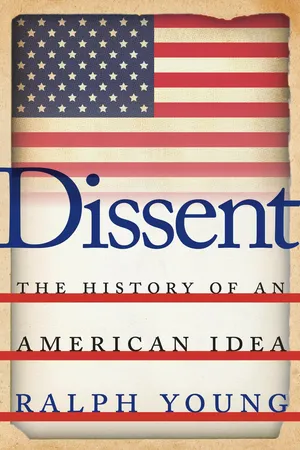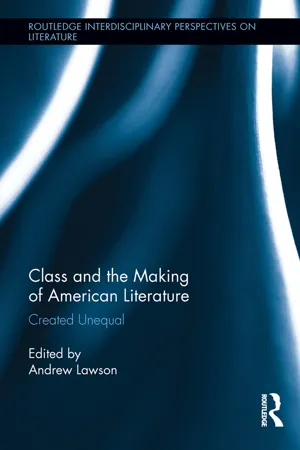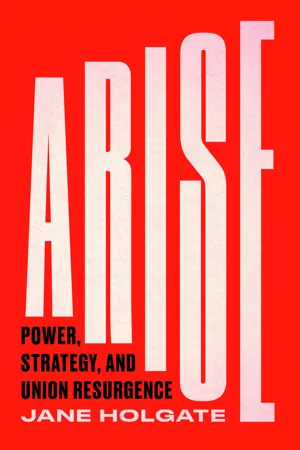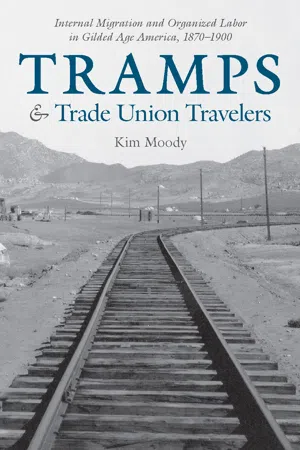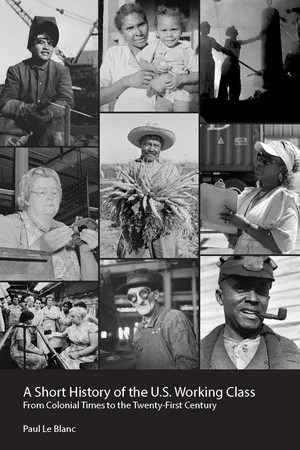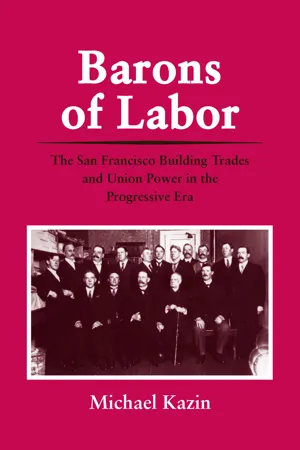History
Labor Unions Gilded Age
During the Gilded Age, labor unions emerged as a response to poor working conditions, low wages, and long hours in industrial workplaces. These unions sought to improve the lives of workers through collective bargaining, strikes, and advocacy for labor rights. Despite facing opposition from employers and the government, labor unions played a significant role in shaping labor laws and improving working conditions for many Americans.
Written by Perlego with AI-assistance
Related key terms
7 Key excerpts on "Labor Unions Gilded Age"
- eBook - ePub
Dissent
The History of an American Idea
- Ralph Young(Author)
- 2015(Publication Date)
- NYU Press(Publisher)
CHAPTER 12Workers of the World Unite!
Workingmen, to Arms!!!! . . . You have for years endured the most abject humiliations; . . . you have worked yourself to death; . . . your Children you have sacrificed to the factory lord—. . . you have been miserable and obedient slaves all these years. Why? To satisfy the insatiable greed, to fill the coffers of your lazy thieving master? When you ask them now to lessen your burdens, he sends his bloodhounds out to shoot you, kill you! . . . To arms we call you, to arms!—August Spies, summoning workers to a rally at Haymarket Square, May 4, 1886The Gilded Age was an era of unprecedented industrial and urban growth, a time of seemingly unlimited expansion of American business. The timber, iron ore, precious metals, and agricultural products from the West were a boon to the economy. Cornelius Vanderbilt, John D. Rockefeller, Andrew Carnegie, J. P. Morgan, and other entrepreneurs created huge monopolies and trusts and seemed to wield more power than the federal government itself. Inventions such as the electric light, the telephone, and the electrification of urban mass-transit systems, as well as innovations such as mass marketing, professional spectator sports, and department stores, transformed daily life.But as the cities grew and the nation rapidly industrialized, so too did serious problems. Political corruption ran rampant in the cities. Unscrupulous employers and landlords took advantage of the poor and the new immigrants flooding in from Europe. Workers had little choice but to take jobs in unsafe factories and industrial plants where they barely earned enough to support themselves. Appalling working and living conditions led to mounting discontent. Discontent led to dissent. Dissent led to activism. Activist workers organized and showed a willingness to go on strike. They called for owners to recognize and negotiate with their unions, and they demanded a living wage and a safe working environment, while farmers, as we have seen, also organized cooperatives and a political party to push for their interests. By the 1890s it seemed that workers and farmers were on the brink of forming an extensive radical coalition that would force the government to address their concerns, recognize their contribution to American prosperity, alleviate their suffering, and protect their rights. - eBook - ePub
Class and the Making of American Literature
Created Unequal
- Andrew Lawson, Andrew Lawson(Authors)
- 2014(Publication Date)
- Routledge(Publisher)
within these groups become more intensive. In aggregate, labor problem novels can be understood as a literary dimension of class formation with both a class expressive and formative role. In short, labor problem stories variously mapped current class relations in formation, contained assessments of how collective actions (e.g., strikes, unions, and militias) were performed, provided evaluative status of class character, and offered blueprints for social change to remedy the labor problem ushered in by industrial capitalism.POLITICAL ECONOMY, CLASS, AND LABOR MOVEMENT
The Gilded Age was a major turning point in the development of the U.S. political economy, marking the rise of industrial capitalism, the rise of a national-level labor movement, and a major shift in the relations and meanings of social class. The United States experienced an enormous surge toward industrial capitalism, the appearance of huge economic enterprises, a transition from proprietary to corporate capitalism, an increasing shift from rural to urban society, and the emergence of new social classes. By the mid-1870s, industrial capital grew and so, too, did the working-class. Economic inequality widened as a consequence. The labor movement grew in size, formed around modern notions of class rooted in wage labor. Signs of cross-trade working-class fraternalism began to appear in labor journals like the Workingman’s Advocate, National Labor Tribune , and others by the early Gilded Age (Montgomery, Beyond ).Cultural boundaries between capital and labor hardened with greater between-class social distance and greater within-class solidarity. Collective action in the labor movement field became much more contentious and lethal (Lipold and Isaac), and the decades of the Gilded Age were repeatedly punctuated with a series of major class struggle flashpoints such as the general strike of 1877 and the Chicago Haymarket Riot of 1886, which served to construct a new political-cultural context. As Reconstruction fizzled and Jim Crow was established across the South, the central issue of the day became the “labor problem” or “labor question.” That problem reached crisis levels and permeated general discourse and all forms of cultural media, including realist fiction. - eBook - ePub
Arise
Power, Strategy and Union Resurgence
- Jane Holgate(Author)
- 2021(Publication Date)
- Pluto Press(Publisher)
3 Harnessing Power in the Late Nineteenth-Century–Early Twentieth-Century ‘Gig Economy’ The purpose of the chapter is to consider the growth and power of unions in the UK in the late nineteenth–early twentieth centuries, when work was almost universally casual and workers had no employment rights. How did workers succeed in collectivising despite the difficult economic and political circumstances of the time, and when there was no labour law to protect workers from the considerable exploitation and threats they faced? There isn’t the space in a short chapter such as this to explore the whole development of trade unionism – that history can be found elsewhere (Clegg 1985; Pelling 1963), but it is important to contextualise how modern trade unions came into being in the late nineteenth century in order to understand the difficulties faced in organising workers, many of whom were in extremely precarious employment without any employment protection, and with no social welfare security when they were out of work. Henry Pelling’s History of Trade Unionism (1963) traces early worker organisations to the sixteenth century, when journeymen (skilled workers with a trade) would form small social societies to enforce work arrangements of mutual advantage. These self-help groups were the forerunners of the Friendly Societies that were developed by workers from the 1700s onward as mutual aid organisations to provide financial assistance in times of hardship (due to death, unemployment and illness). Many of these metamorphosed into pressure groups advocating on behalf of workers who wanted a means to bargain over wages and to restrict entry into craft trades to only skilled workers as a means to protect their jobs and rates of pay. The response from employers and the government was to introduce legislation in 1721 preventing workers from collectively bargaining - Gregory Feldmeth, Christine Custred, Christine Custred(Authors)
- 2015(Publication Date)
- Research & Education Association(Publisher)
Industrial expansion and technology assumed major proportions in this period. Between 1860 and 1894 the United States moved from being the fourth-largest manufacturing nation to the world’s leader through capital accumulation, natural resources (especially iron, oil, and coal), an abundance of labor helped by massive immigration, railway transportation and communications (the telephone was introduced by Alexander Graham Bell in 1876), and major technical innovations, such as the development of the modern steel industry by Andrew Carnegie and electrical energy by Thomas Edison. In the petroleum industry, John D. Rockefeller controlled 95 percent of U.S. oil refineries by 1877.The New SouthBy 1880, Northern capital erected the modern textile industry in the New South by bringing factories to the cotton fields. Birmingham, Alabama, emerged as the South’s leading steel producer, and the introduction of machine-made cigarettes propelled the Duke family to prominence as tobacco producers.Social DarwinismThe theory of Social Darwinism, which asserted that survival of the fittest applied in society as well as nature, gained popularity in the Gilded Age. Many industrial leaders used the doctrines associated with the “Gospel of Wealth” to justify the unequal distribution of national wealth. Self-justification by the wealthy was based on the notion that God had granted wealth to a select few. These few, according to William Graham Sumner, relied heavily on the teachings of Charles Darwin.Labor UnrestWhen capital overexpansion and overspeculation led to the economic panic of 1873, massive labor disorders spread through the country leading to the paralyzing railroad strike of 1877. Unemployment and salary reductions caused major labor conflicts. President Hayes used federal troops to restore order after dozens of workers were killed. Immigrant workers began fighting among themselves in California where Irish and Chinese laborers fought for economic survival.Labor UnionsThe depression of the 1870s weakened national labor organizations. The National Labor Union (1866) had a membership of 600,000, but failed to withstand the impact of economic adversity. The Knights of Labor (1869) managed to open its membership to immigrants, women, and African Americans, in addition to white native American workers. Although they claimed one million members, they too could not endure the hard times of the 1870s, and eventually went under in 1886 in the wake of the bloody Haymarket Riot in Chicago.- eBook - ePub
Tramps and Trade Union Travelers
Internal Migration and Organized Labor in Gilded Age America, 1870–1900
- Kim Moody(Author)
- 2019(Publication Date)
- Haymarket Books(Publisher)
Laurie argues, “As the 1880s drew to a close, German- and English-speaking radicals entered locals of national and international unions affiliated with the AFL.” 125 This trend continued into the new century. Melvyn Dubofsky summarized it for the first decade or so of the twentieth century when he wrote, Not only was socialism making substantial inroads among American workers, especially in such large core unions as the United Mine Workers, the International Association of Machinists, and the United Brewery Workers, but city centrals and state federations of labor also flooded AFL headquarters with petitions and letters demanding the creation of an American labor party. 126 And if the labor press of the Gilded Age declined as the new century arrived, it nevertheless survived and was to a considerable extent supplemented by the national and local socialist press, which increased from about 100 weeklies or monthlies in 1903 to 323 papers and periodicals by 1912. 127 The 1890s would see a more “political” bifurcation within the labor movement with the rise of socialist influence, the brief attraction of Populism, and the eventual but continuously challenged domination of pure and simple ideology. The high-profile strikes at New Orleans (1892), Homestead (1892), Coeur d’Alene (1892), and Pullman (1894) had an impact on the political debate within the AFL, moving some leaders to embrace what Laurie calls “prudential” unionism or outright “pure and simple” unionism, which included a worsening practice toward African American workers, particularly after 1897 as DuBois found, 128 while others were drawn to socialism or industrial unionism or both. Thus, between 1893 and 1894, another effort was made to push labor toward the formation of an independent party through an alliance with the Populists based on the “political program” of Britain’s Independent Labour Party - eBook - ePub
A Short History of the U.S. Working Class
From Colonial Times to the Twenty-First Century (Revolutionary Studies)
- Paul Le Blanc(Author)
- 2017(Publication Date)
- Haymarket Books(Publisher)
chapter 6 “Gilded Age”“Get rich; dishonestly if we can; honestly if we must,” the great novelist and humorist Mark Twain mockingly wrote of the spirit that triumphed throughout the country, a spirit of “money-fever, sordid ideals, vulgar ambitions, and the sleep that does not refresh.” Twain called the post–Civil War period the “Gilded Age” because the glitter of the era covered over widespread corruption. In fact, some historians refer to government generosity to corporations as the period of the “great barbecue,” after the nineteenth-century tradition whereby politicians bribed ordinary voters with a big dinner just before election day. For instance, railroads stretching westward were granted miles of land on either side of new lines. Railroads then sold the land to settlers, and charged them ruinous rates to ship or receive goods. The U.S. government sent troops into the West to clear away the native American peoples (the various Indian tribes) who were obstacles to the economic “progress” represented by the expanding corporate-capitalist economy. Back East, however, it turned its eyes as great fortunes were made selling “watered” stock or manipulating the stock market. In 1873, a severe national depression was triggered when financier Jay Cooke went bankrupt due to overextended railroad investments (although in later years he rebuilt his fortune by shifting from banking to mining). The economic liberty of a few was allowed to create misery for millions. The U.S. Constitution defended citizens’ rights only against governmental abuse, and not against abuse by corporations. In fact, the Fourteenth Amendment to the Constitution, ostensibly written to protect citizenship rights of ex-slaves, was also purposely worded to expand the rights of corporations! Securing democratic control over the industrial economy would not be an easy task.National Labor UnionWhile corporations had a national form, trade-union organizations developed much more slowly. In 1866, workers formed the National Labor Union which focused much of its energies on limiting the work day to eight hours. Boston mechanic Ira Steward played a special role in agitating and educating for reduction of the workday in subsequent years, organizing and winning adherents to the Eight Hour Leagues. Instead of twelve to fourteen hours a day of work, there would be “eight hours for work, eight hours for rest, and eight hours for what we will.” It was iron molder William Sylvis, however, who was the moving force behind the NLU. - eBook - ePub
Barons of Labor
The San Francisco Building Trades and Union Power in the Progressive Era
- Michael Kazin(Author)
- 2022(Publication Date)
- University of Illinois Press(Publisher)
2Like most union leaders in the Progressive era, BTC leaders were professionals. While the typical union official in the nineteenth century had been an impoverished missionary who traveled from city to city preaching the faith and signing up converts, his successors were likely to be homeowning urbanites with a staff of assistants well versed in the techniques of collective bargaining. A heroic national figure like Peter J. McGuire who irregularly collected his weekly salary of $15 while he organized the Carpenters’ Union in the 1880s gave way to such careerists as George L. Berry of the Printing Pressmen who died in 1948 with an estate worth $750,000.3In San Francisco, this transformation occurred quite swiftly—from 1895 to 1905. The temporary locals and paper councils of the Gilded Age had been led by volunteers whose only income came from their craft and who usually depended on individual members rather than paid business agents to enforce union rules. In 1886, Frank Roney, the first president of the Federated Trades Council, considered himself supremely fortunate when, black-balled from his job as a foundry foreman, he used a political connection to secure·a fireman’s job at city hall. There, his boss, a former union seaman, allowed Roney to organize on municipal time. “I began my work as a labor organizer in real earnest,” Roney recalled, “unencumbered with strenuous labor, possessed of a steady job and assured of $80 each month without deductions for loss of time.”4At the turn of the century, the waxing of union strength in the construction and transportation industries brought forth new men of power who built permanent, well-financed organizations and enjoyed life-long tenure. Michael Casey led the San Francisco Teamsters until his death in 1935, and Andrew Furuseth reigned over the Sailors’ Union of the Pacific until 1936 when a CIO revolt forced him to retire. Other leaders advanced from the local bureaucracy to higher posts: SFLC Secretary Andrew Gallagher parlayed his popularity into a seat on the Board of Supervisors, while Paul Scharrenberg, who began as a Furuseth protege, organized the California Federation of Labor and was, for many years, its chief officer and lobbyist.5
Index pages curate the most relevant extracts from our library of academic textbooks. They’ve been created using an in-house natural language model (NLM), each adding context and meaning to key research topics.
